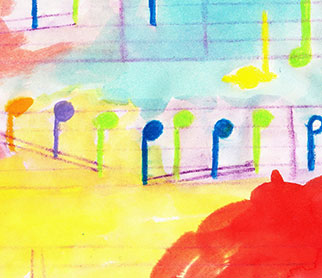To listen is an active process
Listening to music evokes mental processes. The music reminds us of something that happened in the past for example.
We get associations. We judge, compare and valuate the music that we hear. We give it a special meaning or explanation. We think about it.
Expectations play an important role. We always listen in relation to our conscious or unconscious expectations.
How is musical information processed?
Through our senses we get impressions incessantly. All incoming information has to be processed.
In that process we are constantly looking for structures, connections and regularities.
That gets it straight and creates a comprehensible and manageable reality.
How do we structure musical information?
To understand a melody we cluster tones.
To understand rhythms we look for structures and patterns.
Timbre plays an important role. All instruments have a different sound. We recognize them by their timbre.
How does our brain structure musical information? Some examples:
Pitch in a melody: Tones that are near in pitch are perceived as a whole rather than tones that are far apart.
In the whole world melodies are made out of a series of tones with small intervals in between. The tones are near in pitch. Larger intervals are also used of course.
They make the melody more exciting. A melody is mostly build on a series of tones with many small and few large intervals.
Rhythm: Also in time the tones have to be near each other to form an understandable unity. A rhythm is hard to recognize when there is more than 1,5 second between the tones.
We recognize a pattern within an amount of time that we experience as "now".
This "psychological present" lasts only a few seconds for most people. Besides that it is easier to recognize a rhythm if the tones have various lengths, preferably in a ratio of 2:1.
Timbre: We sort according to timbre. If all the tones in a melody would have another timbre, for example because they are played on different instruments, we would not recognize that particular melody.

Categorical perception: Our need to classify information is expressed in "category thinking". We can recognize so much as a thousand different pitches. We count with only 85. For example the tone A1 has a frequency of 440 Hz. But a tone with a somewhat lower or higher frequency, say 430 Hz or 450 Hz, we also consider an A1.
Also tempo is usually divided in categories: Adagio, andante, moderato, allegro, presto.
Duration of tones is divided in 7 categories: Whole note and half note, quarter note, eigth note, sixteenth note, thirty - second note and sixty-forth note.
Even volume is divided in only 7 categories in music notation, from very low (ppp) to very high (fff) volume, in spite of it being a continuum in reality.



 Music influences the mind
Music influences the mind 

